This article was published in Scientific American’s former blog network and reflects the views of the author, not necessarily those of Scientific American
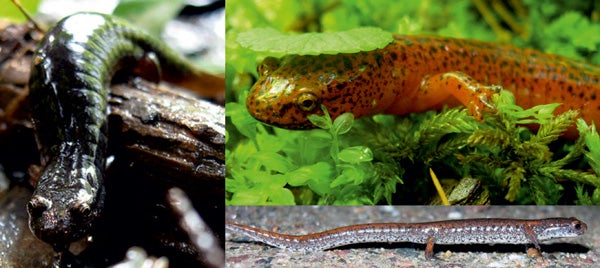
Aren't plethodontids great? Clockwise from left: Northern dusky salamander (Desmognathus fuscus), one of many Desmognathus species within Plethodontinae; Red salamander (Pseudotriton ruber), a spelerpine; Four-toed salamander (Hemidactylium scutatum), the only extant member of its lineage (and hence sometimes given its own ‘subfamily’, Hemidactylinae). All images by Rosemary Mosco and used with permission.
You already know something about salamanders, I’m sure. You’ll therefore be aware of the plethodontids, also called the lungless salamanders. This is a mostly American group and it’s by far the largest salamander group of them all, containing 446 extant species as of right now (August 2015). It’s also one of the most diverse groups as goes morphology, ecology and lifestyle. There are terrestrial, fossorial, aquatic, cave-dwelling and even arboreal species (yes, tree-climbing little salamanders with prehensile tails, and feet that can work as suction pads). For more on this group see the several Tet Zoo articles listed below.
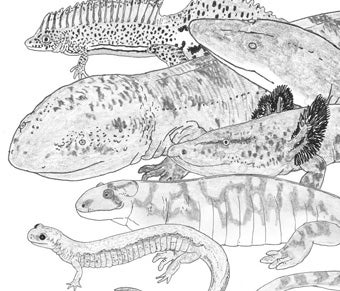
Yeah, I've been drawing salamanders too. The little one at the front is a plethodontid. This and so many other in-prep illustrations are at the Tet Zoo patreon project.
On supporting science journalism
If you're enjoying this article, consider supporting our award-winning journalism by subscribing. By purchasing a subscription you are helping to ensure the future of impactful stories about the discoveries and ideas shaping our world today.
It’s been known for a considerable time that the European cave salamanders (Speleomantes*) are part of this group. And they’re not outside the rest of Plethodontidae, but nested well within it (Frost et al. 2006). Rather than positing an ancestral distribution for the many American plethodontid clades that includes Europe (and thereby also positing multiple extinction events across those hypothesised European lineages), it’s tidier and simpler to assume that a single dispersal event from the Americas gave rise to Speleomantes (Pyron 2014), though exactly when and how this occurred is uncertain. Maybe it’s odd that plethodontids of only one lineage made that crossing, but maybe it’s not.
* Some authors continue to include them within the otherwise North American taxon Hydromantes. Whatever name is used, European cave salamanders seem to be the sister-group to the American Hydromantes clade (Frost et al. 2006, Pyron & Wiens 2011).
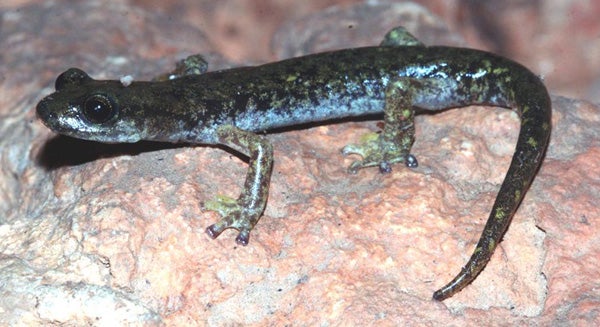
Supramonte cave salamander Speleomantes supramontis, an endemic of Sardinia. Image by Franco Andreone, CC BY SA 2.5.
The presence in Europe of plethodontids is unusual enough (albeit well known), but a major surprise in plethodontid research was the discovery of an Asian member of the group, the Korean crevice salamander Karsenia koreana Min et al., 2005. Plethodontid expert David Wake described its finding as “the most stunning discovery in the field of herpetology during my lifetime”. Karsenia is named for its discoverer, American biology teacher Stephen Karsen who works at the Taejon Christian International School in Korea. It was while leading a class of children into a forest in Chungcheongnam-do, western South Korea, in 2003 that he happened to find one of these salamanders living within a rocky crevice. It was found purely by chance and was sent to Wake, who immediately realised how special it was.
UPDATE (added 19th August 2015): thanks to kind commenters (see below), I now know that a specimen of Karsenia had actually been collected in 1971 at Mount Gyeryong, south-central South Korea, and then kept at the Institute for Amphibian Biology, Hiroshima University. It was recognised as a Karsenia specimen in 2007 and described by Nishikawa (2009). In other words, Karsenia had been sitting in a zoological collection, unrecognised, for more than three decades.
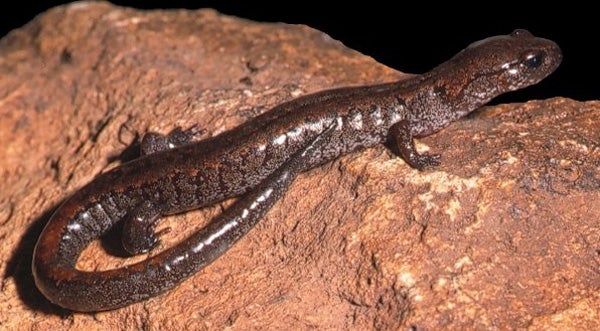
Karsenia in life. Photo by David Vieites/UC Berkeley.
Karsenia is a small, somewhat robust plethodontid that recalls Plethodon in overall appearance (Min et al. 2005). It inhabits limestone-dominated slopes in forested, hilly terrain, hiding under stones and rocks, though virtually nothing else is currently known of its natural history, ecology or behaviour. It’s apparently locally common.
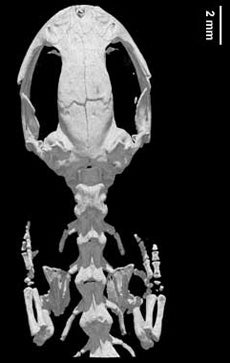
CT-scan of Karsenia's skeleton from the DigiMorph project; available here (Buckley et al. 2010b) and described by Buckley et al. (2010a).
Where does it fit within plethodontid phylogeny? Again, it’s not outside the huge clade that includes all those American species, but deeply nested within it. Some studies indicate that it's part of the clade that includes the Aneides climbing salamanders and the Desmognathus dusky salamanders (Min et al. 2005, Pyron & Wiens 2011), while others find it especially close to the Hydromantes and Speleomantes salamanders (Vieites et al. 2007, Buckley et al. 2010). According to the first hypothesis, all of its close relatives are North American, so it has to be assumed to be an American immigrant, representing a lineage that (based on molecular clock data) apparently made this migration to eastern Asia way back in the Paleogene (Pyron 2014). The second hypothesis is a bit more complex, since it posits a close relationship between Karsenia and a clade that includes both North American and European taxa. Given that we should assume a North American ancestry for that Hydromantes + Speleomantes clade, this hypothesis might imply a separate migration event out of North America for the Karsenia lineage. Or it might be that the Karsenia + (Hydromantes + Speleomantes) clade represents a single Old World invasion, one lineage of which then returned to North America (Vieites et al. 2007).
So, however Karsenia is interpreted within phylogenetic terms, its discovery indicates a long and hitherto totally unknown history of plethodontids in Asia. Furthermore, the fact that only one Asian plethodontid species is known suggests that rates of speciation were far lower among Asian plethodontids than they were among American ones, or even European ones. Or is it that there are other Asian plethodontids to find, either in the fossil record or the extant fauna? No-one has – to my knowledge – reported anything additional yet, but let’s see.
For previous Tet Zoo articles on salamanders, see...
Spiky-frilled, lek-breeding amphibious salamanders… or ‘newts’
Coprophagy and the giraffe-neck program: more on plethodontids
The USA is still yielding lots of new extant tetrapod species
Refs - -
Nishikawa, K. 2009. The first specimen of Karsenia koreana (Caudata: Plethodontidae) collected 34 years before its description. Current Herpetology 28, 27-28.
Pyron, R. A. 2014. Biogeographic analysis reveals ancient continental vicariance and dispersal in amphibians. Systematic Biology 63, 779-797.